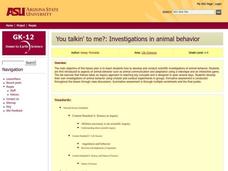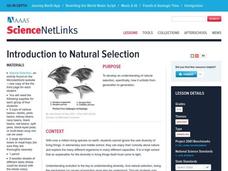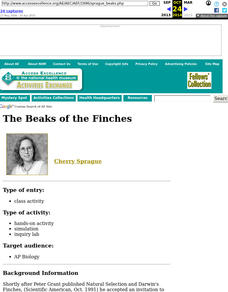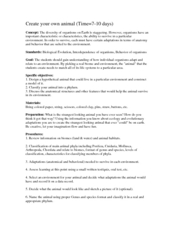Curated OER
Compare Human-made Objects with Natural Objects
Students examine and observe how many human-made objects get their basic design from things in nature. They listen to the book "Nature Got There First," compare/contrast hollow bones with drinking straws, bird beaks and tool pliers, and...
Curated OER
TE Lesson: Can You Taste It?
Students investigate how animals adapt to use its senses to identify foods that are nutritious or noxious. They determine how they associate foods with other things such as birthdays. They discuss the role of the nervous system in the...
Curated OER
Animal Adaptations
Students use items from boxes to dress up classmates as animals adapted to a given environment.
Curated OER
Marine & Aquatic Habitats Activities - Terrestrial Forests vs. Kelp Forests
Students discuss concept and specificity of habitats, both marine and terrestrial, list similarities and differences in the habitats of a kelp forest and a terrestrial forest, compare types of organisms that occupy corresponding types of...
Curated OER
So You Think the World Evolves Around You?
Students examine the topic of evolution as it relates to biodiversity in various remote areas of the world. They watch videos, conduct Internet research, and in small groups create a digital video report to illustrate common evolution in...
Curated OER
Change or Adaptation
Students identify the adaptive forces in the life cycle of plants, animals, and humans, isolate and identify the role that change and adaptation play in extreme environments and research and write a short term paper using MLA citations.
Curated OER
You Talkin' To Me?: Investigations in Animal Behavior
Students investigate a variety of animal behaviors, examine various modes of animal communication, and develop a catalog analyzing, interpreting, and reporting their results.
Curated OER
Camouflage
Third graders collect insects and various bits of the insects' habitats in order to develop an understanding of how camouflage makes the insect fit to survive in its environment.
Curated OER
Keeping Warm When it is Cold: How does a polar bear keep warm?
Students make a model of a polar bear and discuss why fur/skin color is important. They also perform a simple experiment using black and white socks to determine how color affects temperature.
Curated OER
Woodland Animals and Their Habitat
Learners explore the natural environment through a video and nature sounds tape. They keep journal's of the unit's activities and vocabulary terms. They play a web of interdependence game and compose a list of forest animals and write...
Curated OER
Structural and Behavioral Adaptations
Learners participate in a role playing lab that allows students to experience how different beak adaptations play a role in the type of food the animal can eat, therefore playing a role in the survival of the species.
Curated OER
Mammals: Mammals and Their Ways
Young scholars, in groups, observe, collect data, and analyze mammal behaviors.
Curated OER
Making Tracks
Students cast animal tracks on a field trip. They split up to capture tracks from different areas and use plaster of Paris to mold to the footprint. They bring casts back to class, create a negative mold and paint it black.
Curated OER
How Organisms Live Successfully in Their Environments
Students compare the climate and organisms found in different environments, then give examples of how plants and animals adapt to their environment. They design an animal who adapts using camouflage to a made-up environment.
Curated OER
Web of Life - Role-Playing
Students role-play how organisms adapt to their environment. They play 20 questions with plant and animal habitats. They create a web of life to demonstrate how each plant and animal relies on the other for survival.
Curated OER
Introduction to Natural Selection
Learners develop an understanding of natural selection, specifically, how it unfolds from generation to generation. They work in small groups to perform an experiment using beans. They use a worksheet imbedded in this plan to guide their...
Curated OER
The Beaks of the Finches
Students become birds and are given "beak-types". After completing the simulation, students relate results to adaptations and natural selection. Extensions of the simulation allow for comparative results and include population genetics.
Curated OER
Natural Selection and Evidence Worksheet
Matching and fill-in-the-blank exercises give biology whizzes a chance to practice vocabulary associated with evolution. Terms to be reviewed focus on evidence for evolution, natural selection concepts, and some genetics words. You could...
Curated OER
WET Science Lesson #3: Comparison of Aquatic and Terrestrial Plants
Elementary life science explorers compare and contrast aquatic and terrestrial plants (elodea and soybeans) in a Venn diagram. Some background information is provided to support direct instruction, and general instructions are provided...
Curated OER
Structure and Function of Vertebrates - Reading/Notetaking Guide - Amphibians
A variety of questions are presented on the amazing amphibian. Life science intellectuals complete a life cycle diagram, describe characteristics and behaviors, and fill in a metamorphosis flowchart. Content level is geared toward middle...
Curated OER
Create Your Own Animal
Students design and create their own hypothetical animal. In this biology activity, students identify the factors organisms need to survive. They classify their animals according to its correct phylum.
Curated OER
Scavenger Hunt: Simulating Natural Selection
Students simulate natural selection using pinto beans. In this biology lesson, students identify the factors affecting organism evolution. They record data from the experiment and formulate a conclusion.
Curated OER
Pollen & Pollination
Students identify the different ways things are pollinated and how to manage pollen. In this pollination lesson students complete an experiment on how moths pollinate flowers.
Curated OER
Invent a Plant
Learners investigate plant adaptations. For this plant adaptations lesson, students create a model of a plant. Learners are given action cards detailing specific environmental situations. Students design their plant to adapt to the...

























